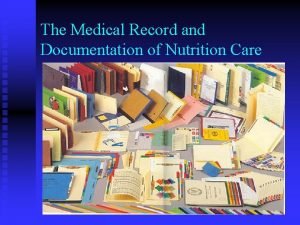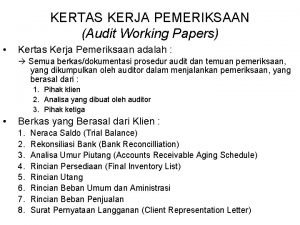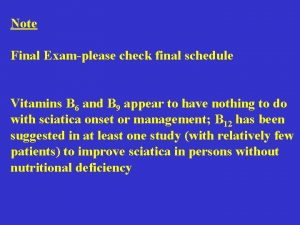Note Final Examplease check final schedule Note Nutrition














- Slides: 14

Note Final Exam-please check final schedule

Note Nutrition 361 - Current Topics in Human Nutrition. Fall 2010 Nutrition 205 - Nutritional Assessment-Theory. Fall 2010 Nutrition 207 -Nutritional Assessment-Application Winter 2011

Lecture 27 - 11 March 2011 Vitamins Fat soluble

Fat soluble These are soluble in fat and generally pose a greater risk of toxicity than do the water soluble vitamins Functions, deficiencies and toxicities sometimes go together Vitamins ADEK List of functions, sources, toxicities and deficiencies are not complete

Vitamin A Functions-vision (cornea health and colour and black and white vision), immune function, reproduction (production of sperm and in females possibly supporting reproductive tract secretions), bone health Sources-beef liver, carrots, sweet potato and chicken liver Deficiencies-blindness and night blindness, reduced immune function, fecundicity and bone health

Vitamin A Toxicities-fatigue, vomiting, abdominal pain, liver toxicity and resulting death(polar bear liver issue), birth defects

Carotenoids Functions- precursor of vitamin A, antioxidants, immune response, cancer, atherosclerosis Sources- carrots, sweet potato, pumpkin Deficiencies-none reported to date unless b-carotene is the sole source of vitamin A Toxicities- yellowish skin but no adverse effects

Vitamin D Function- calcium absorption in the intestine, bone mineralisation, inhibit cell proliferation and enhance cell differentiation Sources-sunlight, fortified milk and cereals Deficiency- rickets in children and osteomalacia and osteoporosis in adults Toxicity- hypercalcemia, depression, nausea, vomiting and loss of appetite

Vitamin E Function- antioxidant(cell membranes, lungs, DNA, heart(atherosclerosis)), maintain b-carotene function Sources-nuts, vegetable and seed oils(soybean, sunflower, canola) Deficiencies-haemolysis, nerve function Toxicity- interferes with vitamin K function, enhances effect of aspirin on clotting

Vitamin K Function- blood clotting, bone mineralisation and maturation Sources- human intestinal bacteria, cabbage, spinach, broccoli and brussel sprouts, soybean oil, canola oil and olive oil Deficiency- rare except in persons with fat absorption problem, infants get vitamin K shot at birth to overcome low bacteria and infants do not get much dietary vitamin K Toxicity- rare since it is excreted much more rapidly than other fat soluble vitamins -interference with anticoagulant drugs

All vitamins Digestion-all vitaminsnot broken down-just released from food Absorptionwater soluble vitamins into blood directly fat soluble vitamins carried across on lipids Transport water soluble travel freely in blood water fat soluble vitamins are carried on lipoproteins

All vitamins Storage Water soluble-in any water soluble environments Fat Soluble-in body fat stores including liver Metabolism vitamins may be metabolised in the body from inactive forms(e. g. b-carotene) to active forms(vitamin A)

Vitamin supplements These are only necessary if the diet and/or pathology prevents presentation of the active form of vitamins where they are needed, when they are needed, in the quantities needed, and at the time they are needed for a particular function in the body Otherwise they are a phenomenal waste of money enriching only the pharmaceutical firms producing and selling them

Vitamin supplements Generally if one follows Canada’s four food groups and eats according to the principles of adequacy, balance, variety, nutrient density, calorie control and moderation, one will not need supplements
 Soap note nutrition
Soap note nutrition Contoh kertas kerja pemeriksaan audit
Contoh kertas kerja pemeriksaan audit Fomema maksud
Fomema maksud Velocity and acceleration quick check
Velocity and acceleration quick check Check in check out forms
Check in check out forms Raster scan line in computer graphics
Raster scan line in computer graphics Cash control system
Cash control system Check in check out behavior intervention
Check in check out behavior intervention Checkin checkout system
Checkin checkout system Check your progress 1
Check your progress 1 Check in check out system for students
Check in check out system for students Check in and check out intervention
Check in and check out intervention Behavior check in check out sheet
Behavior check in check out sheet Where is the check number on a cashier's check
Where is the check number on a cashier's check Intermediate accounting chapter 7 cash and receivables
Intermediate accounting chapter 7 cash and receivables



























